Review for The Castle Of Cagliostro: Double Play (Blu-ray)
Introduction
It’s become something of a set pattern. Twice a year Studiocanal will release the latest additions to the high definition Ghibli catalogue, a few months after the films debut in Japan on Blu-ray. Slowly and surely we’ve been working our way through the back catalogue, occasionally interspersed with the up to date releases of Ghibli’s most recent films like Ponyo and Arriety. If we’d followed the Japanese release schedule as we have been up till now, this autumn would have seen the back catalogue double bill of My Neighbour Totoro and Grave of the Fireflies. A few months ago, the latter film vanished off the release schedule to be replaced with an unexpected title, one which isn’t even a Ghibli film. Instead of Grave of the Fireflies, we’re now getting Hayao Miyazaki’s The Castle of Cagliostro, which he directed prior to the founding of Ghibli. It’s something of a coup as well, as it’s the film’s English language debut in high definition. Studiocanal will be the first company to present it on Blu-ray with the English dub, although it’s been available on Blu-ray in Japan and in Lupin friendly Europe for quite a while now. As usual, they’re releasing it as a dual play release, with Blu-ray and DVD included.
Lupin III is the franchise that just won’t die. Its origins may have been as equally morally dubious as the ethics of its main character, after the manga creator Monkey Punch ignominiously lifted the French Arsene Lupin gentleman thief character and gave him a lecherous grandson, but his manga has spun off into anime and movies, which continue to this day. Most recently, there has been a Fujiko Mine spin off anime series that has attracted a lot of attention, focussing on one of the supporting characters. While the name Lupin could be used in Japan, it’s when the series was first exported to the West that problems with copyright arose, and so the character would often be renamed to The Wolf, or the Japanese pronunciation, Rupan. It’s only when the original Lupin property fell into the public domain that Lupin III could be legally used. Hayao Miyazaki worked on the television anime in the seventies, and he was tasked to direct the Castle of Cagliostro movie, and as you would expect, his take on the Lupin character was really something special.
Incidentally, The Castle of Cagliostro is probably the worst Lupin movie. No, really. Bear with me. For Lupin III as created by Monkey Punch is lecherous, devious, a little mercenary, unprincipled, and self serving. Did I mention lecherous? For The Castle of Cagliostro, while Miyazaki kept these character traits, he toned them down a little, and brought forth Lupin’s noble attributes, his capacity for self-sacrifice, and his heroism. Add to that Miyazaki’s customary brilliance when it comes to directing anime, and the Castle of Cagliostro is unlike any other Lupin movie or indeed the Lupin series. If like me, you watch Cagliostro first, you’ll come away with unrealistic expectations for the character. I watched the Secret of Mamo after Cagliostro and was utterly deflated. Cagliostro is the worst film to watch first, if you plan to explore the rest of the Lupin III universe.
It should have been the greatest heist, ripping off a national casino and getting away with oodles of crisp green money, but during the getaway Lupin discovers that the money is all counterfeit. Not only is his professional pride irked, but there is the very real prospect of his larcenous business being jeopardised if even money guaranteed by national banks proves to be bogus. When Lupin looks closer and recognises the money as goat money, the challenge becomes obvious. It’s fake money that originates from the Duchy of Cagliostro, and he once tried unsuccessfully to break in there when he was younger. Soon Lupin and Jigen are off to the small nation, but on their way, they encounter a damsel in distress, a bride in a 2CV being chased by a black limo full of armed thugs. There’s another challenge that Lupin can’t resist, although his first attempt to do the knight in shining armour thing isn’t that successful. The reluctant bride is Lady Clarisse. She’s engaged to marry the Count of Cagliostro, and she’s being held prisoner in the castle until the fated day. That’s the same castle that is the source of the funny money.
Picture
The Ghibli Blu-rays that have been released by Studiocanal so far have been sourced from Australia’s Madman Entertainment. You can see as much after those films end, and the splash screen shows up with the disc authoring credits. As well as sourcing the Ghibli restorations, some people have observed, somewhat contentiously, that Madman also apply a layer of DNR to their transfers, which offers a comparatively de-grained look to the films.
That isn’t so with The Castle of Cagliostro, which as far as I can tell, hasn’t got an Australian release scheduled at this time. Neither is there a disc authoring credit page apparent to offer a source for the transfer. You’ll find a lot of difference between this and the Madman prints. The Castle of Cagliostro gets a 1.85:1 widescreen presentation on this Blu-ray disc, but at the 1080i resolution encoded at 60Hz. It doesn’t look as if any extensive restoration was done to the image, although it is pretty clear of print damage and dirt. The image is a tad soft, with some signs of interlacing apparent, mostly evident in the optional subtitles. There is a smidge of aliasing on some line detail, and the occasional pan or scroll will be a little juddery, but by and large this is a fair transfer, with the film exhibiting smooth, detailed animation. The Blu-ray format also brings out the best in the film’s colour palette. What’s immediately apparent is the film source. There’s been no grain reduction here, and the image is rich in grain, as well as being prone to the odd frame jump common to cel animation, with some moments of cine wobble. It looks just the way a film should look. It’s a shame that a 24p transfer couldn’t have been sourced.
Sound
You have the choice between DTS-HD MA 5.1 Surround Japanese, along with PCM 2.0 mono English and Japanese, with optional translated English subtitles. The presence of the original mono is a nice touch, although I stuck with the surround track for the duration, which is itself little more than a glorified mono up-mix. There’s a smidge of ambience, and the odd effect thrown to the side speakers, but otherwise it’s a distinctly front-focussed affair that reflects the original audio adequately. The dialogue is clear throughout, free of drop-outs or glitches, and also free of hiss and other such artefacts. The subtitles are accurately timed and are free of error. According to the PR material supplied by Studiocanal, the English dub on the disc is the Manga dub, although I only sampled it. Throughout the film, Lupin is called Wolf instead, reflecting the copyright issues I mentioned earlier.
Extras
Compared to the Ghibli discs, The Castle of Cagliostro is light on extra features. You get the Picture in Picture storyboards, which are displayed in the top left hand corner of the screen.
You’ll also find the very SD looking trailer for the film, although it’s presented at 1080i 50Hz resolution, albeit in letterbox format. You can use it to see how much of an improvement the Blu-ray image is, although since you also get the DVD in the case (which I didn’t receive a review copy of), a more obvious comparison is at hand.
The disc presents the film with an animated menu.
Conclusion
The Castle of Cagliostro is an odd evolution on Miyazaki’s CV. It comes at that point where he was transitioning away from the conveyor belt of TV animation, just prior to setting up Studio Ghibli. Here he was hired to tell someone else’s story, and he had to operate under certain constraints and conditions. It’s a useful reminder now, when most of Miyazaki’s recent output through Ghibli has been variations on fairy tales, that he has other strings to his bow. It’s been a while since we’ve seen an eco-message like Mononoke or Nausicaa, or slice of life like Kiki’s Delivery Service. The Castle of Cagliostro is an early example of the sort of action adventure that he would make with Porco Rosso, and Laputa: Castle in the Sky. I still find The Castle of Cagliostro to be one of Miyazaki’s better films. It’s entertaining, exciting, thrilling, funny, and more importantly lean, with no excess fat on the script at all, no let up in the pacing.
The Castle of Cagliostro works on two levels, for fans of the Lupin III franchise, and as a standalone movie. I would guess that fans coming to the film having seen the TV series and the other films would be justified in feeling a little disappointed. As a film, it focuses primarily on Lupin and his attempts to uncover the counterfeiting operation while saving Clarisse from the clutches of the nefarious Count. There’s also the added draw of a secret treasure that tantalises his larcenous side. As mentioned earlier, this is a noble and upright Lupin though, one who restrains his libido even when the chaste Clarisse declares her love for him. Jigen provides able sidekick support, but long term fans may be disappointed at the sidelining of Goemon and Fujiko almost to the background, although Lupin’s perennial nemesis, Inspector Zenigata does have a stronger role in the film. But they do often feel like guest stars in their own movie. Truth be told, I didn’t even realise the significance of the Fujiko Mine character until I’d seen The Secret of Mamo.
On the other hand, if like me you come to The Castle of Cagliostro without any of the baggage that comes with the other Lupin shows and movies, then the film really is a treat. It is a perfectly paced action adventure, with great characterisations, a sharp and engaging script and some breathtaking action set pieces. Even after over two decades, the car chase at the start of the film is one of the best animated car chases I have yet seen, even though the cars involved obey the rules of cartoon physics at times. When you think of this film, a whole host of such scenes will spring to mind; breaking into the castle through an aqueduct, fending off an army of rooftop ninjas, and the climax atop the clock tower. It’s a succession of magical cinema moments, from an animator at the top of his game.
For Lupin fans, this may just be the worst of the Lupin films, given what it does to the characters. For everyone else though, this is still one of the best films that Miyazaki has made. It’s swash-buckling entertainment from beginning to end, with sharp writing, brilliant action, and animation that even now, some two decades later, looks astounding. Of course The Castle of Cagliostro isn’t a Ghibli film, and consequently hasn’t had the extensive restoration that the Ghibli catalogue is receiving right now. But un-restored, it still looks pretty nifty on this Blu-ray.
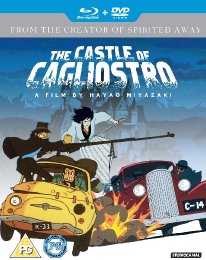

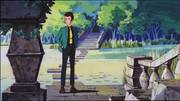
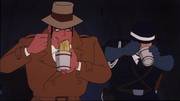
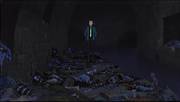
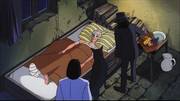
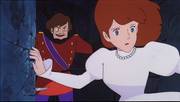




































Your Opinions and Comments
Be the first to post a comment!